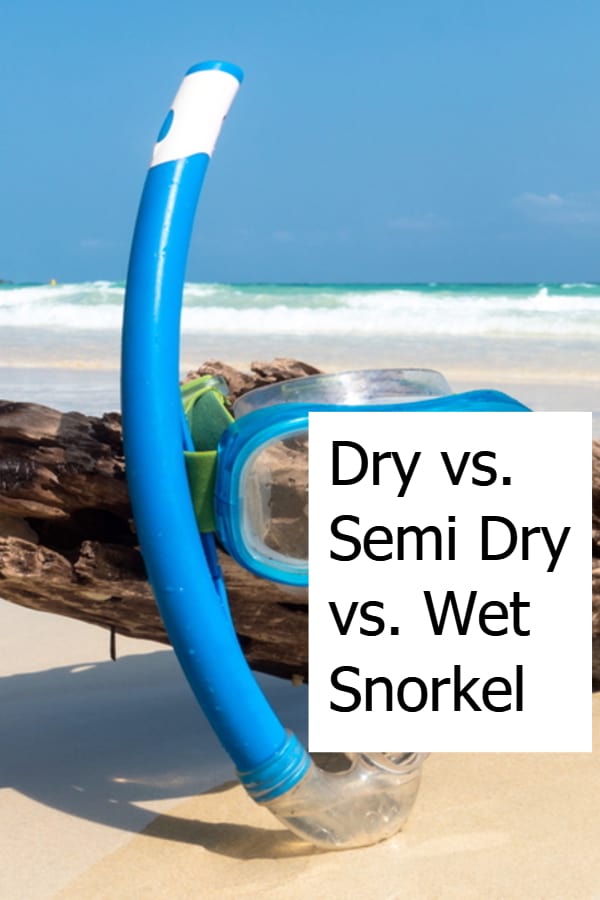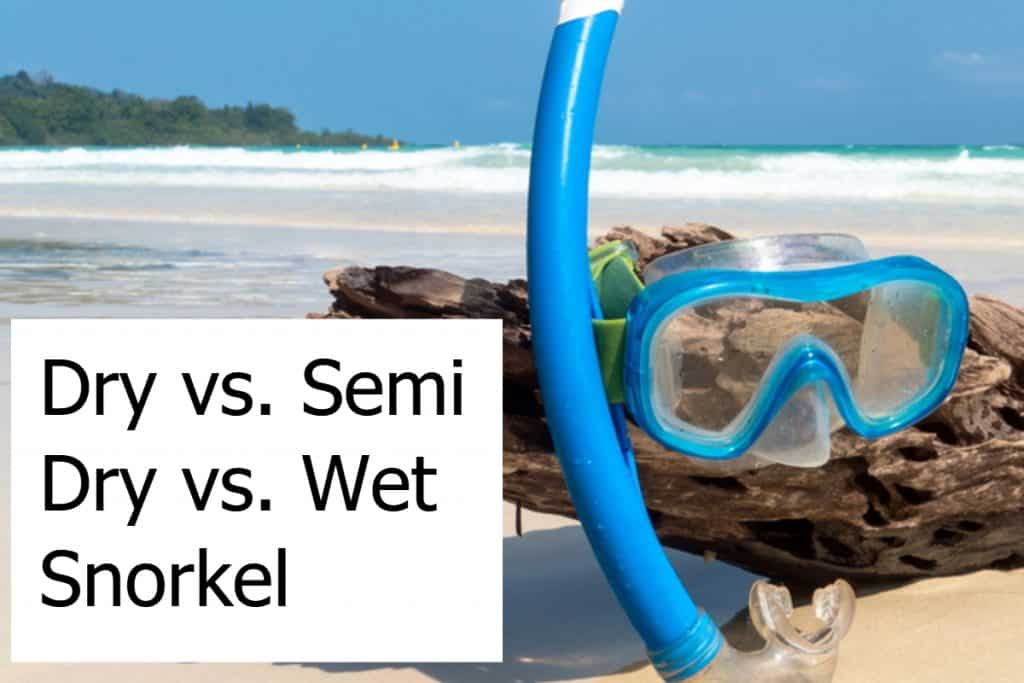Dry vs. Semi Dry vs. Wet Snorkel – What are the Differences?
Over the decades, snorkels for scuba diving and snorkeling have seen quite a bit of innovation. In the old days, there were only wet snorkels with uncomfortable mouthpieces. One thing that you could count on in those days was that you’d end up drinking a lot of water.
How these types of snorkels differ from each other
Development slowly moved from these wet snorkels to semi-dry and dry snorkels. Specifically, the dry snorkels had real design flaws in the early days.
These first dry snorkels were dry when you went underwater but once you surfaced again, they more often than not didn’t open up again so you had to completely come out of the water to get some air. A modern dry top snorkel will not suffer from those issues.
Nowadays you can find three different kinds of snorkels which we will go over in the post below. These types are:
- Wet Snorkel
- Semi-Dry Snorkel
- Dry Snorkel
Modern Snorkels
These days where dry snorkels didn’t work that well are thankfully over. The design and technology have evolved and today these dry snorkels work reliably and yes, they do stay dry. A dry snorkel has a float valve on top of the snorkel tube that keeps water out. That is if you are using a dry snorkel. Today you can even have full-face snorkel masks with integrated dry snorkels that work wonderfully and use a reliable float valve on top to keep the water out – are full-face snorkel masks dangerous?
Now, not all things are great about that. While in the old days the snorkel did fill with water, that had advantages when you had the snorkel with you while scuba diving. They didn’t produce any buoyancy. You want to keep that in mind if you are looking for a new snorkel.
A dry snorkel will be air-filled and cause an upward lift. A semi-dry snorkel will fill with water which makes it easier when you dive. The basic rule is that it’s great to get a dry snorkel when you snorkel but not when you dive! In case that you want to dive you should look for semi dry snorkels or wet snorkels.
But these are not the only considerations to think about. You want to make sure that the mouthpiece fits comfortably. That depends on the size and material of the mouthpiece. You will find that most mouthpieces today are made from high-quality silicone. If you have a small face or have kids, then you also have to make sure that the snorkel you get fits the size of the head.
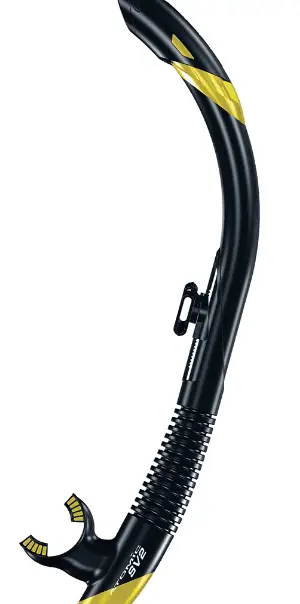
Finding the Best Full Face Snorkel Mask for Kids – Reviews and Advice
Types of Snorkels
Besides dry, semi-dry, and wet snorkels, you also have a choice when it comes to the tube. It can be flexible or rigid no matter whether you’re looking at a wet or dry snorkel. Many, if not most, snorkels today have a flex tube which makes it easier to fit the mouthpiece comfortably.
Rigid Snorkel – Dry vs Wet
The rigid snorkel is basically a solid plastic tube with a mouthpiece. They are typically bent to somewhat fit a generic form of a face.
These are basically the same design as what was used since the old days. That also means that they typically are wet snorkels. Once you get them underwater the tube will fill with water. When you come above water again you will have to clear the tube with a forceful blow of air.
Dry snorkels as well as semi-dry snorkels are newer in design and therefore have more modern features. Modern snorkels are usually somewhat flexible. Many, if not all, have a purge valve to be able to get the water out without needing too much air.
Snorkel Terms and Options
Below we go more into the details on different options and terms around snorkels.
Flexible Tube for Dry or Wet Snorkel
Wet, dry-top, or semi-dry snorkels that have a flexible tube are usually more comfortable to wear. The snorkel tube is not a single rigid piece of plastic pipe. Instead, there is a flexible piece of pipe where the snorkel bends between the attachment point and the mouthpiece.
The result of using such a flex tube is a better fit no matter what shape your head is. Another benefit of the flex tube is that there is less pull on the mouthpiece. Additionally, you can adjust the mouthpiece and the top of the snorkel so they sit at a better, more comfortable angle. Lastly, when you let go of the mouthpiece, it pulls away from your face and is not in the way.
Purge Valve for Snorkels
Most modern dry-top or semi-dry snorkels have a purge valve. The purge valve is usually located at the bottom part underneath the silicone mouthpiece. This is where water coming down the snorkel tube collects. This area is below your mouth so that the collected water will not get into your mouth and you can easily use the purge valve to expel any water.
Small amounts of water will collect there. At the very bottom of that collection area, you will find a purge valve. When you blow into the snorkel the valve will open and the water will be forced out. This requires much less effort than in old designs where you had to blow really hard to force the water out the top of the snorkel.
The disadvantage is that dirt or sand can get into the valve. At that time, the purge valve might no longer work and you will have to give it a good cleaning.
How Deep Can You Snorkel Dive? What do you need to know to underwater snorkel?
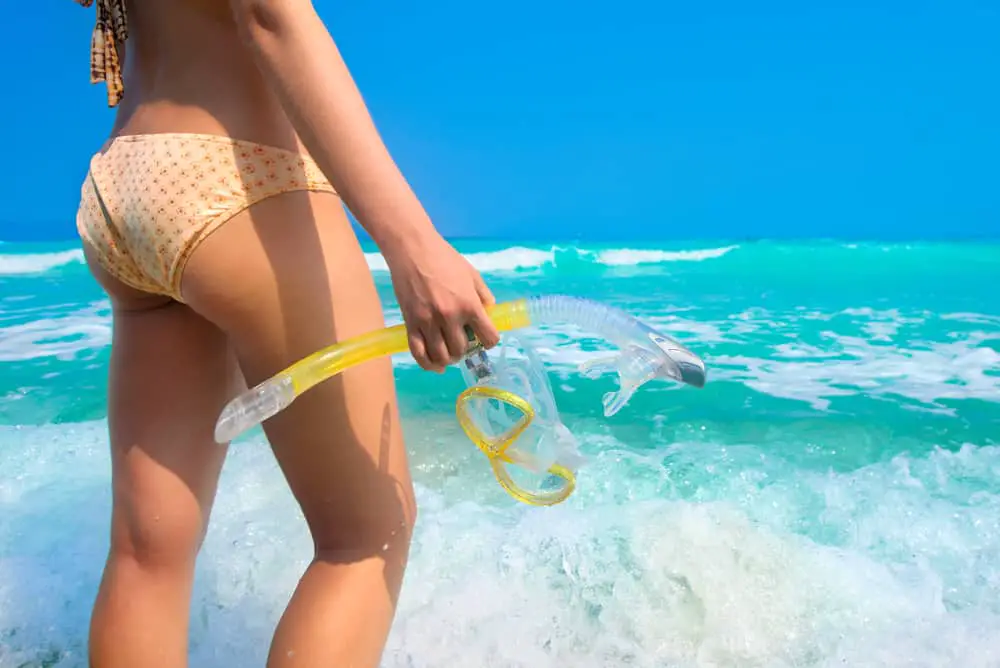
Splash Guard on Semi-Dry Snorkels
A splash guard sits on the top of semi-dry snorkels. It also is what makes a snorkel a semi-dry snorkel. Most of these snorkels have a flexible tube and a purge valve.
The splash guard on semi-dry snorkels prevents water and sprays to enter the tube. It does not prevent water from entering the snorkel when you dive. Also, if a sizeable wave rolls over your snorkel, water will come in.
It does prevent a lot of splashing water from entering the snorkel. This makes it a lot more comfortable to use than a wet snorkel. Allowing the snorkel to fill with water when diving makes it a great choice for divers.
Dry Valve on the Snorkel
The dry valve sits on top of the tube. This float valve prevents water from entering the snorkel. In the early days of dry snorkels, these dry valves often did not work as desired.
Such a dry-top mechanism prevents water from entering the tube either didn’t create a tight seal and water entered the snorkel or they closed up when they were supposed to be open. That prevented air to come in which is certainly anything but a good thing.
Modern designs do not have those issues anymore. They work reliably and keep the water out and let you breathe when you have to. The valve completely seals when you go underwater and then opens up again when you get above water.
As the snorkel will not fill with water when you go underwater, it does create buoyancy through the air trapped in the snorkel. This makes it harder when you dive to get down. On the other hand, it makes it perfect when you only want to snorkel.
Should you end up diving with a dry snorkel then be aware that when you dive down to more than 15 or 20 feet your tube might collapse. The air inside the snorkel can’t withstand the pressure of the surrounding water anymore and the flexible portion of the snorkel can (will) collapse. Nothing to be too worried about as a scuba diver but it can be a surprise when it happens.
What kind of snorkel should you buy?
That depends very much on what you want to use the snorkel for. If you want to snorkel and not dive then you definitely want a dry snorkel.
Best Dry Snorkel
One of the best ones you can get is the Cressi Supernova Snorkel. It’s completely dry and is very affordable. This dry snorkel is ergonomically shaped and will fit your head nicely. It has a purge valve and has a highly flexible tube.
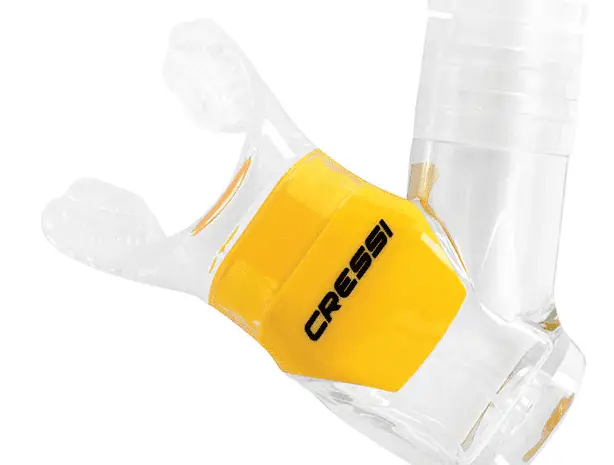
Best Semi-Dry Snorkel
If you want to dive with the snorkel, then get a semi-dry snorkel. It will fill with water during a dive which makes it easier to dive down. The splash guard will prevent the splashes of water come in while you snorkel but then it does not create buoyancy when you dive.
A great semi-dry snorkel to get is the ScubaPro Escape Semi-Dry Snorkel. It has a large draining chamber to collect water and is overall highly rated by customers.
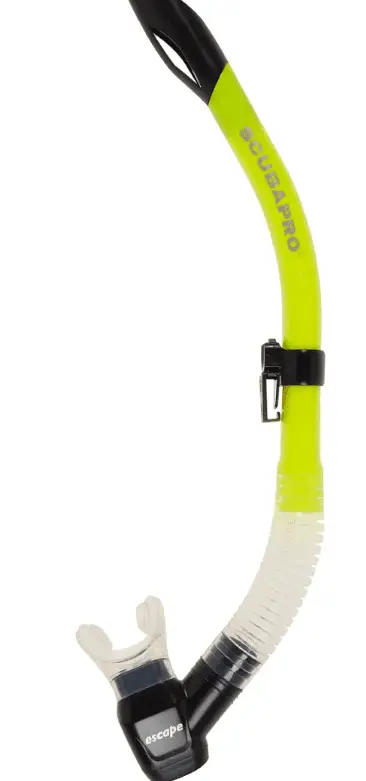
Wildhorn Outfitters Seaview 180 Degree V2 full face snorkel mask
Other Considerations
Besides the points we have made above, you also want to think about the following topics.
Full-Face Snorkel Mask
Another alternative to a traditional scuba mask and snorkel is to get a full-face snorkel mask. The advantage is that they cover the whole face which allows you to breathe through your mouth or nose.
No Mouthpiece on the Snorkel!
There’s no need for a mouthpiece! These masks are usually very comfortable to wear and they stay dry. The large window allows for great visibility underwater. Have a look at our best full-face snorkel masks review to learn more about these kinds of masks/snorkels.
Replacing Parts
You’ll have a hard time breaking a mouthpiece of a modern snorkel. However, it potentially could happen and it would be good to know that the mouthpiece can be replaced without having to replace the whole snorkel.
Now, having said that, snorkels nowadays are very affordable. Even the best snorkels can be had for under $50. So, while it theoretically is a consideration to be able to replace a mouthpiece it really is not worth thinking about it too much.
Mask Strap Release
When traveling it is usually necessary to separate the snorkel from the mask strap. Many snorkels today have releases that make it easy to remove the snorkel from the mask strap. It’s not a concern for the quality of the snorkel itself but it does make it easier to travel with your mask and snorkel.
Sizing
The size aspect of a snorkel is mainly related to the size of the mouthpiece. A smaller person typically will have a smaller mouth and as such would be more comfortable with a smaller mouthpiece.
In addition, a smaller person will most likely have a lower lung capacity. So, if you are smaller and you’re getting a snorkel without a dry-top then don’t forget that you have to blow hard to get the water out of the snorkel. It would be more comfortable to have a tube with a smaller diameter that will require less air to blow the water out.
Considerations for Children and Youths
The same reason(s) make it important to have a kid-sized snorkel for kids. Children have an even harder time using an adult snorkel and blowing it out. A great kid-sized snorkel that is dry is the Cressi Junior Dry Snorkel.
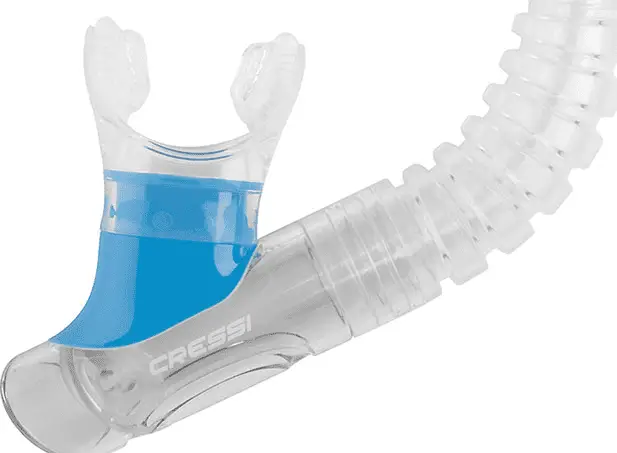
Tribord Easybreath Review – The best full-face snorkeling mask?
Final Thoughts on Wet vs Dry Snorkels
Modern snorkels, like a dry snorkel, work reliable and help you to snorkel or dive. If you want to snorkel then you’re best off using a dry snorkel that prevents water from getting into the tube. Scuba divers will want to use a semi-dry snorkel which allows for easier diving.
If you like to both snorkel and dive then you’re best off to simply buy two snorkels, one semi-dry, and one dry snorkel. They are pretty cheap and you won’t have to compromise on either activity.
Make sure you pick snorkels with a purge valve and an easy mask strap release to make it easier to use the device.
